
Looking for How to Make Home Canned Nuts (all types: peanuts, walnuts, pecans, almonds, etc.) with Your Pressure Canner - Easily! in 2025? Scroll down this page and follow the links. And if you bring home some fruit or vegetables and want to can, freeze, make jam, salsa or pickles, see this page for simple, reliable, illustrated canning, freezing or preserving directions. There are plenty of other related resources, click on the resources dropdown above. If you are having a hard time finding canning lids, I've used these, and they're a great price & ship in 2 days.
If you have questions or feedback, please let me know! There are affiliate links on this page. Read our disclosure policy to learn more.
How to Make Home Canned Nuts (all types: peanuts, walnuts, pecans, almonds, etc.) with Your Pressure Canner - Easily!
Yield: as many pint jars or half-pints, as you like
Making and canning your own nuts (peanuts, almonds, walnuts, pecans, hazelnuts, etc.) has been relatively easy to do. Canned nuts has the advantage of producing shelf-stable jarred nuts that will last for at least a year, stored in a cool dark place, like a basement. The USDA says that freezing is easier and produces as satisfactory a product, but that takes up room in a freezer!
OTE: Since I first published this recipe several years ago, the USDA's National Center for Home Food Preservation has taken their directions down. They provided the following explanation as a question and answer:
Q. There are no recommendations for canning nutmeats by themselves, but
is it okay to include nuts in conserves?
A. Yes, if processing
recommendations for recipes containing nuts have been properly developed
and tested as a safe canned product, there is no reason to worry about
them containing nuts as one ingredient. Nuts are a common component of
conserves, including our canned conserve recipes. Overall product and
recipe characteristics affect those canning recommendations. Although we
do not have a recommendation for canning jars of only shelled nutmeats,
we still recommend our recipes that contain nuts as one ingredient.
BOTTOM LINE: I don't think I would can nuts; I'd freeze them. If you do choose to use this recipe, you assume the risk!
Alternatively, you can store nuts in sterilized canning jars without putting them through a canning process. To store nuts this way, it's important that you heat and dry them first. Shell the nuts and spread them in a single layer on baking pans. Then place them in a 250°F oven until they are dry, but not brown or scorched, stirring occasionally. Allow them to cool at room temperature and simply put them in sterilized canning jars, covering with lids and ring bands.
Other recommendations
Sterilizing jars provides
extra protection against mold spores that could be on the jars. To sterilize
jars, submerge them in boiling water for 10 minutes. Remove them from the
water and sit them with open end down to allow them completely dry before
filling with nuts.
Be aware that with any nuts, rancidity will
eventually develop, making the product unappealing though not unsafe.
Rancidity occurs in foods when fats or oils are exposed to oxygen over time,
causing oxidation which leads to that yucky off-flavor. You might want to
buy oxygen absorber packets to put in the jars. They will get rid of some of
the oxygen, increasing their shelf-life. These packets are widely used in
the food industry in products like bacon bits, jerky, etc. Multiple sources
can be found on the Internet.
And although a Pressure Canner
costs $100 to $200 (see this page for pressure canners models, makes and prices), they last a lifetime, and your children and grandchildren may be using
it. You can also find free information from the USDA in this PDF
file (it will take a while to load!) about
selecting and using canners here!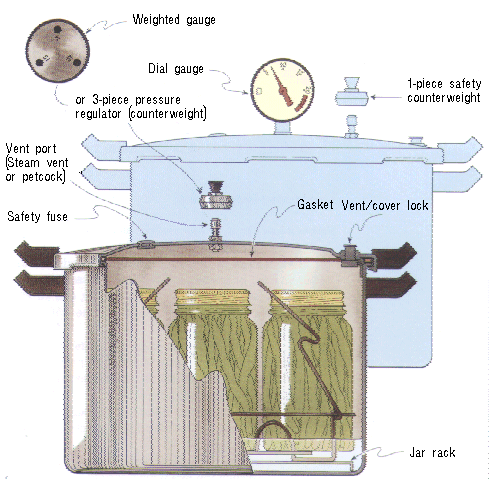
So, here's how to pressure can nuts of all types. The directions are complete with instructions in easy steps and illustrated. In the winter when you open a jar, the nuts of all types will taste MUCH better than any store-bought canned nuts.
Prepared this way, the jars have a shelf life of about 12 - 24 months, and aside from storing in a cool, dark place, require no special attention.
Ingredients
- Nuts - any type: peanuts, almonds, walnuts, pecans, hazelnuts, etc., and quantity.
Equipment
- 1 Pressure Canner (a large pressure pot with a lifting rack to sanitize the jars after filling (about $75 to $200 at mall kitchen stores and "big box" stores, but it is cheaper online; see this page for more information). For low acid foods (most vegetables, you can't use an open water bath canner, it has to be a Pressure Canner to get the high temperatures to kill the bacteria. If you plan on canning every year, they're worth the investment.
- Jar grabber (to pick up the hot jars)
- Jar funnel ($4 at mall kitchen stores and local "big box" stores, but it's usually cheaper online from our affiliates)
- At least 1 large pot
- Colander or sieve
- Large spoons and ladles,
- Canning jars (often called Ball jars, Mason jars or Kerr jars) (Publix, Kroger, other grocery stores and some "big box" stores carry them - now about $12 per dozen quart jars (up 50% in 2 years!) including the lids and rings)
Directions - Step by Step
Step 1 - Prepare the jars, oven and pressure canner
Wash the jars and lids
This is a good time to get the jars ready! The dishwasher is fine for the jars; especially if it has a "sanitize" cycle. Otherwise put the jars in boiling water for 10 minutes. I just put the lids in a small pot of almost boiling water for 5 minutes, and use the magnetic "lid lifter wand" (available from target, other big box stores, and often grocery stores; and available online - see this page) to pull them out.
Get the pressure canner heating up
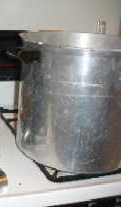 Rinse out your pressure canner, put the rack plate in the bottom, and
fill it to a depth of 4 inches with hot tap water. (of course, follow
the instruction that came with the canner, if they are different). Put
it on the stove over low heat, with the lid OFF of it, just to get it
heating up for later on.
Rinse out your pressure canner, put the rack plate in the bottom, and
fill it to a depth of 4 inches with hot tap water. (of course, follow
the instruction that came with the canner, if they are different). Put
it on the stove over low heat, with the lid OFF of it, just to get it
heating up for later on.
Start heating the oven
This is also a good time to get the oven preheating to 250°F (120°C)
Step 2 - Shell the nuts.
Perhaps it isn't obvious, but yes, you do need to shell the nuts and discard the shells (the shells make great mulch in your garden).
Step 3 - Bake the nuts
Spread a single layer of nut meats on baking pans and place in a 250°F oven. Stir the nuts occasionally, heating only until the nut meats are dry but not browned. Watch carefully that they don't scorch. This just to preheat the nuts prior to the pressure canning step.
Step 3 - Pack the nuts into the jars
Pack hot nuts into half pint or pint jars, leaving 1/2 inch headspace. Do not add any liquid to the jars. Wipe jar rims. Adjust lids and process. Keep moving, so the nuts don't cool down much.
Step 4 - Put the lids and rings on
Put the lids on each jar and seal them by putting a ring on and screwing it down snugly (but not with all your might, just "snug"). Again, keep moving.
Step 5 - Put the jars in the canner and the lid on the canner (but still vented)
Using the jar tongs, put the jars on the rack in the canner. By now the water level has probably boiled down to 3 inches. If it is lower than that, add more hot tap water to the canner. When all the jars that the canner will hold are in, put on the lid and twist it into place, but leave the weight off (or valve open, if you have that type of pressure canner).
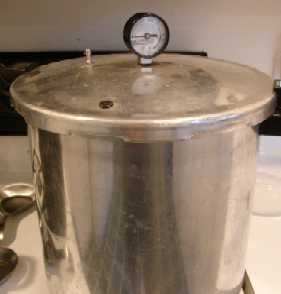 Step 6 - Let the
pressure canner vent steam for 10 minutes
Step 6 - Let the
pressure canner vent steam for 10 minutes
Put the heat on high and let the steam escape through the vent for 10 minutes to purge the airspace inside the canner.
Step 7 - Put the weight on and let the pressure build
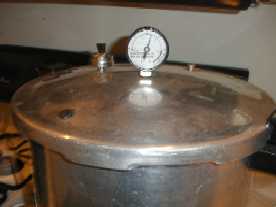 After 10 minutes of venting, put the weight on and close any openings
to allow the pressure to build to to the pressure in the the table in
step 8 below!
After 10 minutes of venting, put the weight on and close any openings
to allow the pressure to build to to the pressure in the the table in
step 8 below!
Step 8 - Process in the pressure canner for 10 minutes
Once the gauge hits 6 pounds, start your timer going - for 10 minutes. Adjust the heat, as needed, to maintain pressure.
Note: the chart at below will help you determine the right processing time and pressure, if you have a different type of canner, or are above sea level.
It is important to learn how to operate your pressure canner by reading the owner's manual that came with your particular canner. If you cannot find your owner's manual, you can obtain find one online: Here is where to find some common manufacturer's manuals:
or by contacting the company that made your canner. Give the model number to the manufacturer, and they will send you the right manual. Click here for more information about pressure canners and a variety of models you can order.
|
Table 1. Recommended process time for Nut Meats in a dial-gauge pressure canner |
||||||
|
|
Canner Gauge Pressure (PSI) at Altitudes of |
|||||
|
Style of Pack |
Jar Size |
Process Time |
0 - 2,000 ft |
2,001 - 4,000 ft |
4,001 - 6,000 ft |
6,001 - 8,000 ft |
|
Hot |
Half-pints or Pints |
10 min |
6 lb |
7 lb |
8 lb |
9 lb |
|
Table 2. Recommended process time for Nut Meats in a Weighted-gauge pressure canner |
||||||
|
|
Canner Gauge Pressure (PSI) at Altitudes of |
|||||
|
Style of Pack |
Jar Size |
Process Time |
0 - 1,000 ft |
Above 1,000 ft |
||
|
Hot |
Half-pints or Pints |
10 min |
5 lb |
10 lb |
||
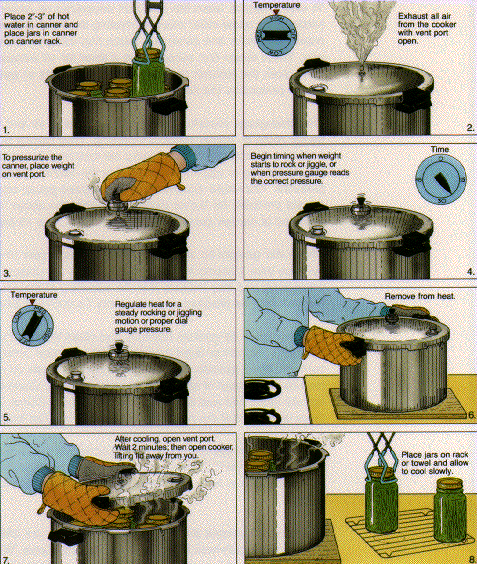
Step 9 - Turn off the heat and let it cool down

When the processing time from the chart above is up, turn off the heat, and allow the pressure canner to cool and the pressure to drop to zero before opening the canner. Let the jars cool without being jostled. After the pressure drops to zero (usually, you can tell but the "click" sound of the safety release vents opening, as well as but the gauge. Let the pressure in the canner drop to zero by itself. This may take 45 minutes in a 16-quart canner filled with jars and almost an hour in a 22-quart canner. If the vent is opened before the pressure drops to zero OR if the cooling is rushed by running cold water over the canner, liquid will be lost from the jars. Too rapid cooling causes loss of liquid in the jars!
Step 10 - Remove the jars
Lift the jars out of the water and let them cool on a wooden cutting board or a towel, without touching or bumping them in a draft-free place (usually takes overnight), here they won't be bumped. You can then remove the rings if you like, but if you leave them on, at least loosen them quite a bit, so they don't rust in place due to trapped moisture. Once the jars are cool, you can check that they are sealed verifying that the lid has been sucked down. Just press in the center, gently, with your finger. If it pops up and down (often making a popping sound), it is not sealed. If you put the jar in the refrigerator right away, you can still use it. Some people replace the lid and reprocess the jar, then that's a bit iffy. If you heat the contents back up, re-jar them (with a new lid) and the full time in the canner, it's usually ok. You're done!
The jars of nuts are safe to store on the shelf, preferably a cool, dark
place, for 1 to 2 years.
This document was extracted from "So Easy to Preserve", 5th ed. 2006. Bulletin 989, Cooperative Extension Service, The University of Georgia, Athens. Revised by Elizabeth L. Andress. Ph.D. and Judy A. Harrison, Ph.D., Extension Foods Specialists.
Tips
Comments and Feedback
USDA recommendation about not canning nuts:
The following is from the USDA website:
In light of recent research looking at survival of Salmonella bacteria in
low moisture foods, our concern has arisen about canning processes for nuts.
Even after drying, the nuts may be exposed to moisture during canning
processes. Although it is not likely that your particular batch of nuts is
contaminated with Salmonella, the risk is present and exposure to moisture
could be an issue.
Therefore Cooperative Extension, University of
Georgia and the National Center for Home Food Preservation no longer offer a
procedure for canning nut meats, with the single exception of our current
procedure for green peanuts. USDA canning recommendations are unaffected, as
they have no recommendations for canning nuts of any kind.
Looking for canning equipment and supplies?
Water bath canner with a jar rack
Pressure canners for gas, electric and induction stoves: Presto 23Qt or T-fal 22Qt
Canning scoop (this one is PERFECT)
Ball Blue book (most recent version)
Jars: 8oz canning jars for jams
Find Other types of farms:
Farm markets and roadside stands
Road trips and camping resources
Local Honey, apiaries, beekeepers
Consumer fraud and scams information
Home canning supplies at the best prices on the internet!
Maple Syrup Farms, sugarworks, maple syrup festivals
Environmental information and resources
Farms For Your Event for birthday parties, weddings, receptions, business meetings, retreats, etc.
Festivals - local fruit and vegetable festivals
Get the
most recent version of
the Ball Blue Book
With this Presto 23 quart pressure canner and pressure cooker, you can "can" everything, fruits, vegetables, jams, jellies, salsa, applesauce, pickles, even meats, soups, stews. Model 01781

You can make jams, jellies, can fruit, applesauce, salsa and pickles with water bath canners, like this Granite Ware 12-Piece Canner Kit, Jar Rack, Blancher, Colander and 5 piece Canning Tool Set


